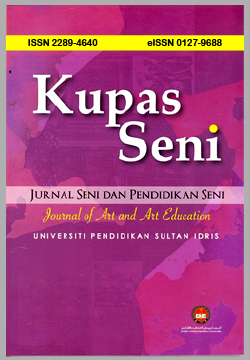Designing an Assistive Color Code for The Visually Impaired with Braille Touch
DOI:
https://doi.org/10.37134/kupasseni.vol10.2.4.2022Keywords:
Color Code, Visually Impaired, Low Vision, Blind, Braille TouchAbstract
The basis of this project is to create a color code using Braille touch specially designed with complete details to be placed on the garment. This study aims to analyze how clothes and Braille affect each other in providing information in the design, how to coordinate clothes according to color by color code, and to overcome the challenges of wearing clothes amongst visually impaired people. This project is to contribute and achieve SDGs 9 and 11 which are related to Industry, Innovation and Infrastructure, and Sustainable Cities and Communities. Braille becomes a major element in designing color code by entering the details required to convey information. It also plays a role in terms of color identifications to visually impaired people using a braille touch that has been designed with various shapes to represent each color code. This information must be on the garment to satisfy the requirements of the visually impaired community. Incorporating fashion elements and components on a color code that focuses on braille touches is a special solution for this visually impaired people. Many struggles the unseemly faced, difficulties include daily clothing identification and clothing choices made without assistance. This color code is focused on functionality and practicality. It is a very practical approach in helping them to dress and to live independently in the future. Raising the awareness of society, upgrading individual thinking, and creating innovative designs for emulated by future generations, and also to make Malaysia a country that helps achieve the goals of SDGs over period and time.
Downloads
References
Abdul Karim, Khairi Asyraf. (2020). The challenges faced by visual impairments in buying clothes and how to wear clothes. Idealogy Journal, [S.l.], v. 5, n. 2, p. 73-78, sep. 2020. ISSN 2550-214X.
Raghad Alali. (2017). A case study of visually impaired individuals’ preferences of the availability of braille clothing labels in shopping and selection of apparel. Applied Sciences and Technology, 6-17.
Cinthia Di Ciancia. (2017). Sónar, an inclusive insight. Retrieved from https://welum.com/article/sonar-inclusive-insight/
United Nations. (2018). Build resilient infrastructure, promote inclusive and sustainable industrialization and foster innovation. Retrieved from https://sdgs.un.org/goals/goal9
United Nations. (2018). Make cities and human settlements inclusive, safe, resilient and sustainable. Retrieved from https://sdgs.un.org/goals/goal11
M. Leona Godin. (2021). There plant eyes: A personal and cultural history of blindness. Knopf Doubleday Publishing Group, 31-47.
Paul Simpson. (2021). The colour code: Why we see red, feel blue and go green. Great Britain, 1-15.
World Health Organization. (2021). Blindness and vision impairment. Retrieved from https://www.who.int/news-room/fact-sheets/detail/blindness-and-visual-impairment
Peter Ackland., Serge Resnikoff., & Rupert Bourne. (2017). World blindness and visual impairment: despite many successes, the problem is growing. Community Eye Health Journal, 71-73.
Feelipa Color Code. (2020). For the visually impaired. Retrieved from https://feelipa.com/for-visually-impaired/
Cavazos Quero, L., Lee, C.-H., & Cho, J.-D. (2021). Multi-sensory color code based on sound and scent for visual art appreciation. Electronics 2021, 10, 1696. https://doi.org/10.3390/electronics10141696
Roberta Kelly Cardoso Fernandes., Nataly Araujo Pinheiro., & Livia Juliana Souza Solino. (2019). Development of products aimed for the tactile perception of children with visual disabilities. Product: Management & Development, Vol. 17 no 2 December 2019. https://doi.org/10.4322/pmd.2019.011
Lee, Y., Lee, C.-H., & Cho, J.D. (2021). 3D sound coding color for the visually impaired. Electronics 2021, 10, 1037. https://doi.org/10.3390/electronics10091037
Ramsamy-Iranah., Sabrina., Martin Maguire., James A. Gardner., Satyadev Rosunee., & Naraindr Kistamah. (2019). A comparison of three materials used for tactile symbols to communicate colour to children and young people with visual impairments. Loughborough's Research Repository, figshare. https://hdl.handle.net/2134/20746
Jabbar, M.S., Lee, C.-H., & Cho, J.D. (2021). ColorWatch: Color perceptual spatial tactile interface for people with visual impairments. Electronics 2021, 10, 596. https://doi.org/10.3390/electronics10050596
Cho, J.D. (2021). A study of multi-sensory experience and color recognition in visual arts appreciation of people with visual impairment. Electronics 2021, 10, 470. https://doi.org/10.3390/electronics10040470
Cho JD., Quero LC., Bartolomé JI., Lee DW., Oh U., & Lee I. (2020). Tactile colour pictogram to improve artwork appreciation of people with visual impairments. Color Res Appl. 2020;1–14. https://doi.org/10.1002/col.22567
Downloads
Published
Issue
Section
License
Copyright (c) 2022 Khairi Asyraf Abdul Karim

This work is licensed under a Creative Commons Attribution-NonCommercial-ShareAlike 4.0 International License.





